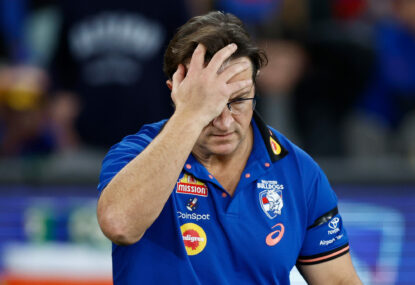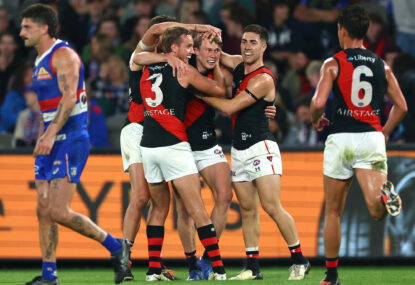With most Western Bulldogs fans relishing their club’s first appearance in a grand final in 55 years – for many, the first in their lifetime – it’s worth taking a moment to consider how Luke Beveridge and the players have achieved what looked near impossible at the start of the 2015 season.
It’s worth reminding ourselves that the Bulldogs started this season paying $67 to win the premiership, and have just become the first team in AFL history to make a grand final from seventh spot.
Furthermore, it’s a relatively young squad, with plenty of first, second and third-year players in the starting 22. Little wonder that Bulldogs fans might feel both ecstatic and a little bewildered that Bevo’s young charges have made it this far.
There is definitely something unique about the Bulldog game plan and the manner in which they play. If I were to summarise it in a few words, it’s about ultra-fast and clean handball.
Obviously, that’s not enough to explain the Bulldogs’ success on its own, after all, teams have been using handball to release players in the clear for decades now.
And we only need go back to Adelaide’s famous preliminary final win over the Bulldogs in 1997, by which time, the ‘Crow throw’ had already entered the footy vernacular. So ultra-fast handballing has been around for a while.
No, there’s something more to what the Bulldogs are doing, and we got a hint during the week when the Herald Sun quoted All-Australian defender, Matty Boyd talking about an inner circle and outer circle.
Now we are getting a bit closer to the heart of the matter.
While contested footy, clearances and favouring stoppages over coughing up the footy are all part of the mix, it’s this inner/outer circle idea where the Bulldogs have created something which gives them an edge – as long as the game is played on their terms.
We see further evidence of this game style in the post-game press conference given by Hawthorn coach, Alastair Clarkson, after Hawthorn’s loss to the Bulldogs a couple of weeks back.
He made a comment about laying 104 tackles, but only receiving three free kicks for holding the ball.
In basic terms, this is what the Bulldogs do.
1. One player (or two) in and under;
2. A premium on getting both hands on ball to either shovel out quickly or be tackled with no prior opportunity (ball up – rinse and repeat);
3. An inner circle of two or three players, only one or two metres from the ball and from each other – if the quick ball comes out from the player in and under, that player puts a premium on either shovelling out to the next one, or being tackled with no prior opportunity (ball up – rinse and repeat);
4. There might need to be a ring-a-rosy of quick, short handballs around the inner circle, but that is ok, little chance to intercept, and the worst case scenario is being tackled with no prior opportunity (ball up – rinse and repeat); and
5. In that ring-a-rosy of three, four or five ultra quick handballs to the bloke next to you, a half-metre of space might open up to get it out to the outside circle, who in turn will have that split second of time to spot a teammate – up with either a long hand ball or a short pass.
The game plan is all about encouraging mayhem and chaos, and backing yourself to be the one to get it out cleanly by both the way the Bulldogs structure themselves around the ball with extra numbers, and intense training on short, sharp handballing in tight spaces.
Via the game plan, the Bulldogs will lock in their forward line for sometimes three or four minutes at a time, an extraordinary amount of time in the context of an AFL game.
You will see whole swathes of the game where the bulldogs are winning clearances (or at least semi-clearances) something like 80-20, where they are progressing down the field a few metres at a time. Perhaps the second or third of the inner circle has taken the tackle with no prior opportunity.
Another plank of the game plan is all players are expected to be able to play all three roles at any given moment: in and under; inner circle and outer circle. All players, going deep into the VFL side, are well drilled in all roles.
However, both Hawthorn and the Giants did expose weaknesses in the game plan.
1. The Bulldogs cannot maintain that 80-20 split in semi-clearances, a good team will at least even the score for large parts of the game;
2. Hawthorn, and to a lesser extent the Giants, would have a loose man outside of the Bulldogs’ outer circle, and if the ball reaches that player, it’s a guaranteed scoring opportunity every time. There is a touch of Russian roulette in the Bulldogs’ game plan, they do commit extra numbers to the contest; and
3. Talls – the Giants had three of them and they nearly won the game for them. At times, the Bulldog defenders were giving away four or five inches to the Giants. Just a bit more quality ball into that forward 50 and it’s game over.
In summary, it’s not just about the fast, clean handball. It’s about the manner in which the Bulldogs structure themselves around the ball, and being well drilled in choosing, or not choosing, the option of keeping the ball in the inner circle before it’s worked out to the outer circle.



































































































